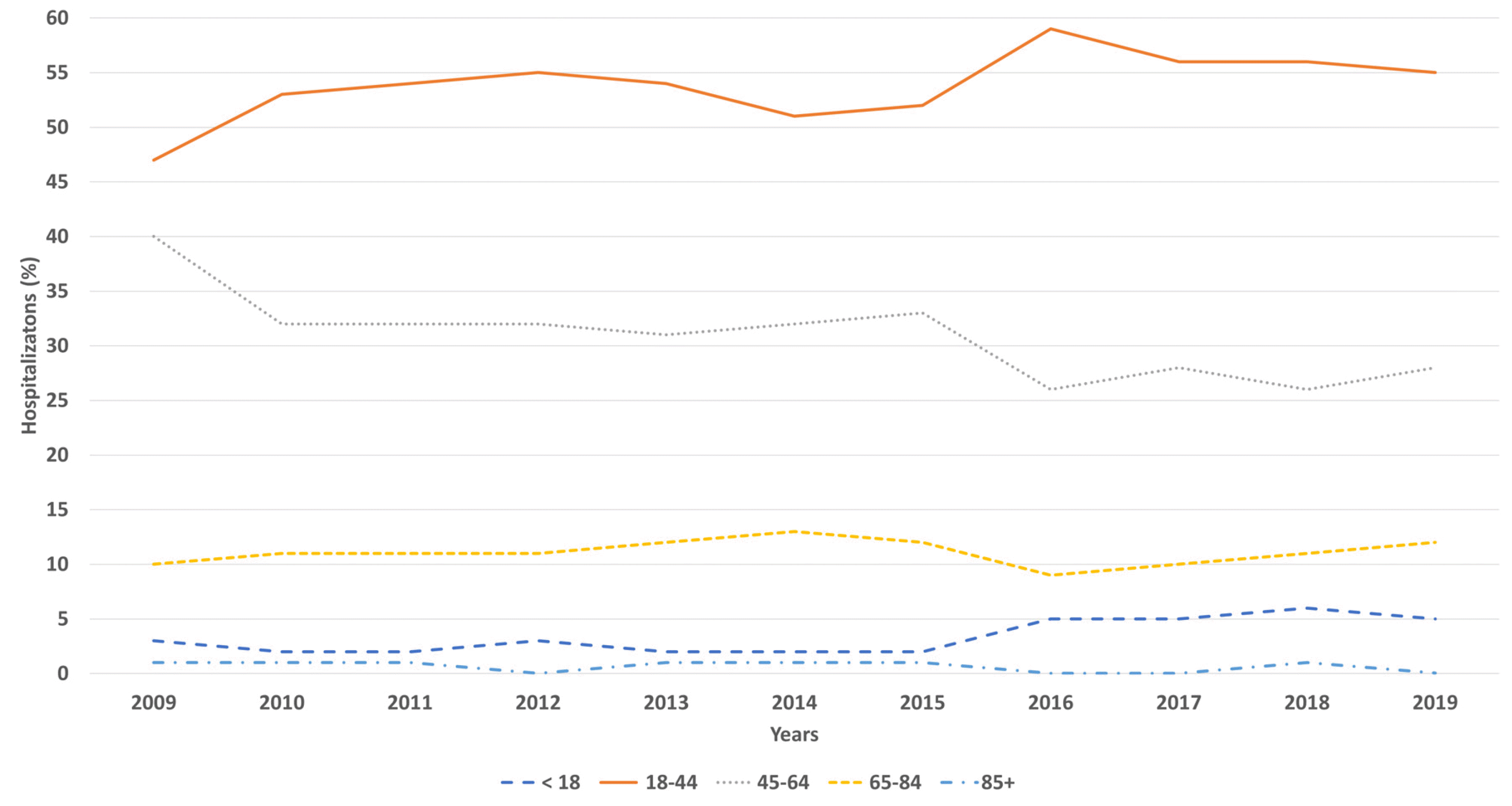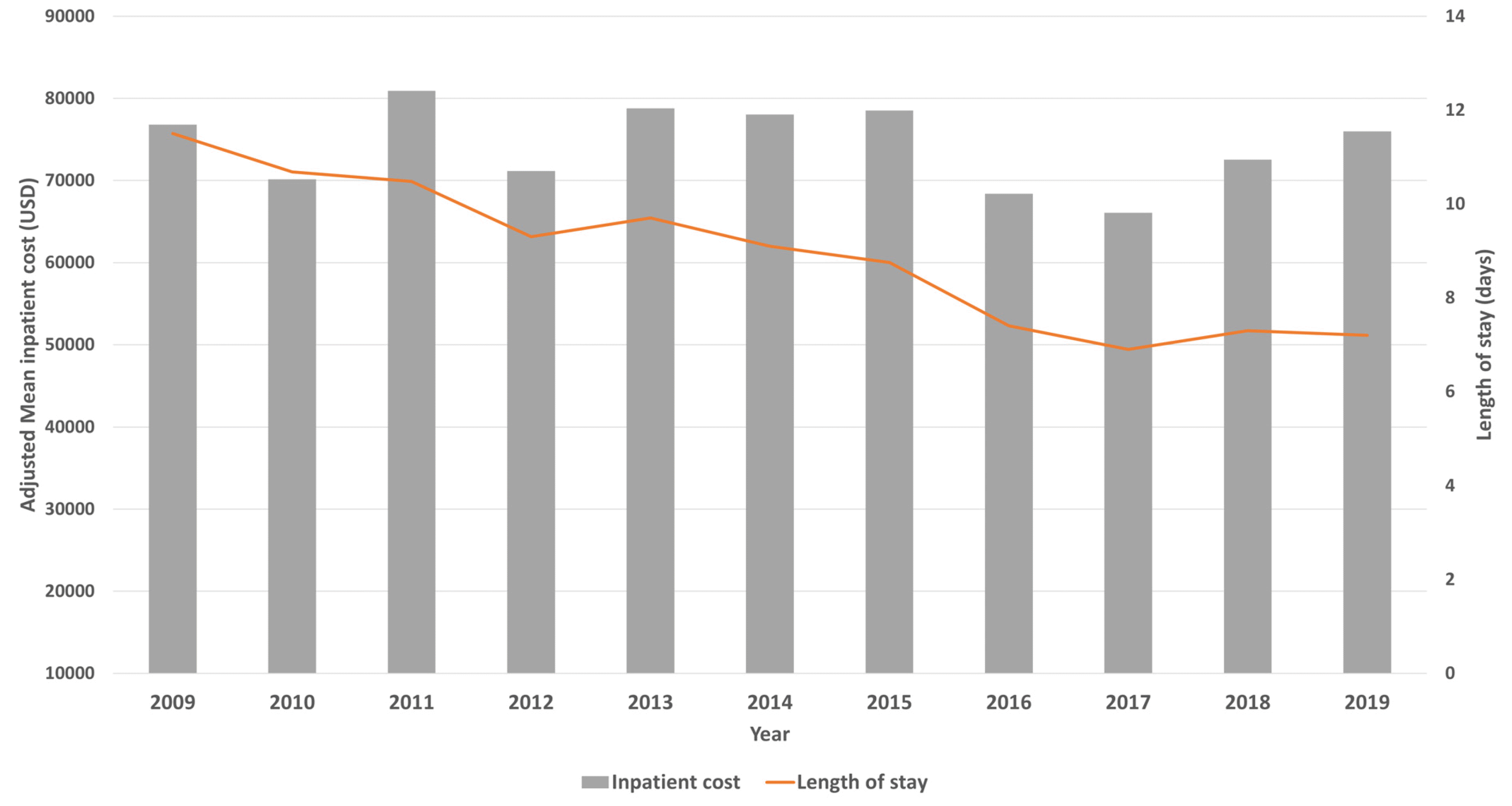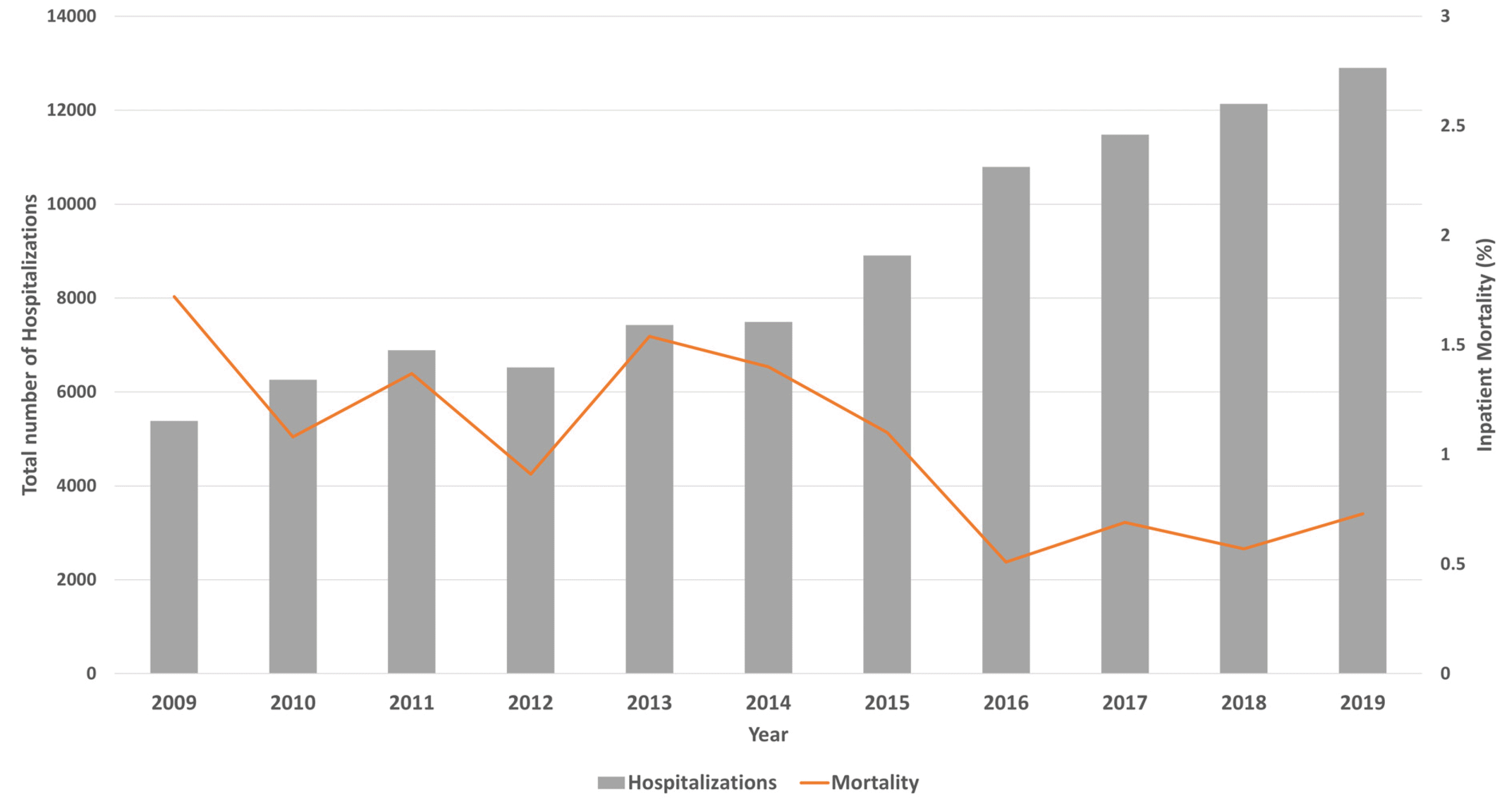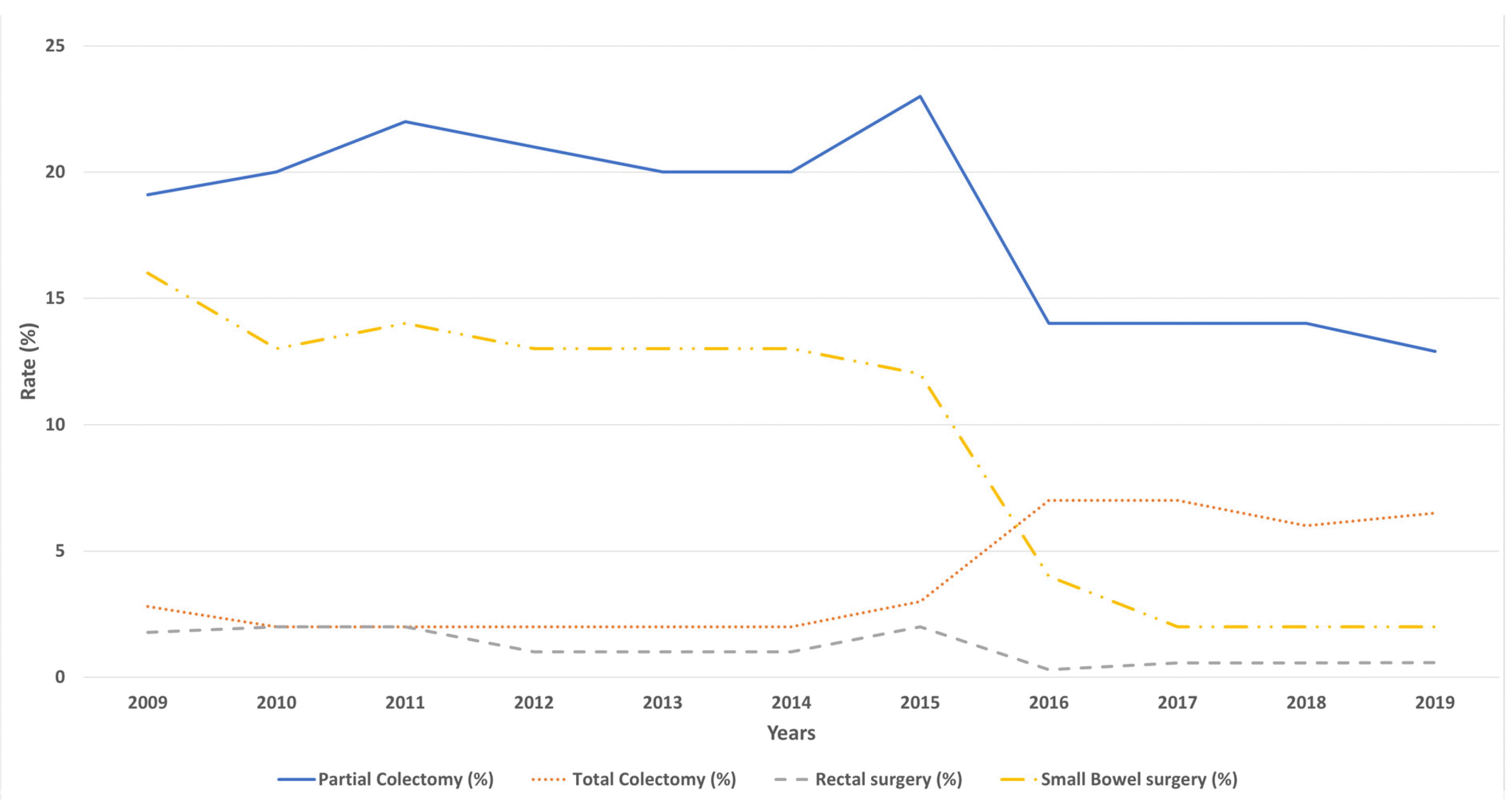INTRODUCTION
Crohn’s disease (CD) and ulcerative colitis constitute inflammatory bowel diseases that pose a major burden to the US health system every year. In 2004, there were 1.1 million ambulatory visits and 1.8 million prescriptions written for Crohn’s disease.
1 In 2010 alone, the total number of hospitalizations for CD was estimated to be 187,000.
2 Compared to UC, there were 716,000 ambulatory visits and 2.1 million prescriptions written for UC in 2004.
1 In 2010, 107,000 hospitalizations were secondary to UC.
2
Fistula formation is a common manifestation in patients with CD that affects approximately 50% of patients within the first 20 years of initial diagnosis.
3,4 Fistulas are classified as a simplex of complex depending on the number of tracts, the relation of the external anal sphincter, and the presence of complications like abscess or stricture formation.
5 Complex strictures are associated with a poor prognosis and are more likely to require surgical procedures like proctectomy or stoma formation.
6 The presence of a fistula in patients with CD poses a significant burden in terms of morbidity and quality of life.
7 Limited data is available regarding the trends in CD patients specific to fistulas in patients from the United States. This study aimed to identify the trends of fistula in terms of hospitalizations, cost, population distribution, and mortality in patients with CD using a retrospective analysis from NIS data, specifically in the United States.
Go to :

RESULTS
There was an increase in the total number of fistulizing CD hospitalizations from 5,386 in 2009 to 12,900 in 2019 (p<0.01). The mean age ranged from 44.9±0.6 to 41.8±0.4 years, with a significantly declining trend over the study period (p<0.01). Males and females had a similar proportion of hospitalizations. Racial disparities were present, with Caucasians being the predominant ethnicity, followed by Africans, Hispanics, and others (
Table 1). Subgroup analysis revealed a significant upward trend among those 18-44 years and a decline in age groups 45-64 years (p<0.001) (
Fig. 1). For hospitalizations between 2009-2019, private payers were the largest insurer. This was followed up by Medicaid and Medicare (
Table 1).
 | Fig. 1Trend in the number of admissions in patients with a diagnosis of fistulizing Crohn’s disease from 2009-2019 in United States hospitals based on age groups, Nationwide Inpatient Sample data 2009-2019. 
|
Table 1
Biodemographic Characteristics of Hospitalizations for Irritable Bowel Disease (Crohn’s Disease) with Fistula from 2009-2019
|
Variable |
2009 |
2010 |
2011 |
2012 |
2013 |
2014 |
2015 |
2016 |
2017 |
2018 |
2019 |
|
Hospitalizationsa
|
5,386 |
6,259 |
6,888 |
6,525 |
7,425 |
7,495 |
8,905 |
10,790 |
11,480 |
12,135 |
12,900 |
|
Mean age (years)±SE |
44.8±0.7 |
43.2±0.7 |
43.0±0.6 |
42.2±0.5 |
43.1±0.5 |
43.9±0.5 |
44.1±0.5 |
40.1±0.4 |
41.0±0.4 |
41.0±0.4 |
41.8±0.3 |
|
Women (%) |
52 |
49 |
50 |
52 |
47 |
50 |
48 |
50 |
49 |
52 |
51 |
|
Racial distributiona
|
|
|
|
|
|
|
|
|
|
|
|
|
White |
81 |
78 |
75 |
77 |
77 |
78 |
78 |
73 |
73 |
71 |
73 |
|
Black |
11 |
14 |
15 |
15 |
14 |
13 |
14 |
18 |
18 |
17 |
17 |
|
Hispanic |
4 |
3 |
6 |
4 |
6 |
5 |
5 |
6 |
5 |
6 |
6 |
|
Asian |
1 |
1 |
1 |
<1 |
1 |
1 |
1 |
1 |
1 |
2 |
2 |
|
Others |
3 |
4 |
3 |
4 |
3 |
3 |
2 |
2 |
3 |
3 |
2 |
|
Insurance type (%)a
|
|
|
|
|
|
|
|
|
|
|
|
|
Medicare |
22 |
28 |
26 |
24 |
27 |
28 |
26 |
23 |
25 |
24 |
25 |
|
Medicaid |
15 |
15 |
17 |
16 |
17 |
18 |
20 |
23 |
22 |
21 |
22 |
|
Private |
58 |
51 |
51 |
55 |
50 |
49 |
50 |
51 |
50 |
51 |
48 |
|
Uninsured |
6 |
7 |
6 |
5 |
6 |
4 |
3 |
3 |
4 |
4 |
5 |

The mean LOS for fistulizing CD hospitalizations was 11.57±0.09 days in 2009 and 7.20±0.05 in 2019, respectively. The mean inpatient cost for these hospitalizations was 76,791±6,047 in 2009 and 75,987±6,011 in 2019 (
Fig. 2). The adjusted multivariate regression trend analysis did not reveal a statistically significant trend for the MIC for the study period, but the change in LOS was significant (p<0.01). Adjusted multivariate regression trend analysis revealed a statistically significant trend toward decreasing inpatient mortality from 1.72% in 2009 to 0.73% in 2019 (p<0.01) for all hospitalizations (
Table 2,
Fig 3). There was a decreasing trend towards partial colectomies for CD hospitalizations from 19.1% in 2009 to 12.9% in 2019 (p<0.001), but the rate of total colectomies increased from 2.8% in 2009 to 7% in 2016 and later declined to 6.5% in 2019 (p<0.001). The rate of rectosigmoid surgeries also declined significantly from 1.78% in 2009 to 0.58% in 2019 (p<0.001) (
Fig. 4). The rate of small bowel surgeries declined significantly from 16% in 2009 to 1.8% in 2019 (p<0.001) (
Fig. 4).
 | Fig. 2Trend in the inpatient cost and hospital stay in patients with a diagnosis of fistulizing Crohn’s disease from 2009-2019 in United States hospitals, Nationwide Inpatient Sample data 2009-2019. 
|
 | Fig. 3Trend in the number of admissions and mortality (%) in patients with a diagnosis of fistulizing Crohn’s disease from 2009-2019 in United States hospitals, Nationwide Inpatient Sample data 2009-2019. 
|
 | Fig. 4Trend in the partial, total colectomies, rectosigmoid surgeries, and small bowel surgeries (%) in patients with a diagnosis of fistulizing Crohn’s disease from 2009-2019 in United States hospitals, Nationwide Inpatient Sample data 2009-2019. 
|
Table 2
Adjust Hospitalization Outcomes of Hospitalizations for Irritable Bowel Disease (Crohn’s Disease) with a Fistula from 2009-2019
|
Outcome |
Inpatient mortality (%)a
|
Mean length of stay (days)±SEa
|
Mean total hospital cost ($)±SE |
|
2009 |
1.72 |
11.50±0.09 |
76,791±6,047 |
|
2010 |
1.08 |
10.60±0.07 |
70,164±6,145 |
|
2011 |
1.37 |
10.40±0.09 |
80,937±8,672 |
|
2012 |
0.91 |
9.30±0.10 |
71,162±6,434 |
|
2013 |
1.54 |
9.70±0.05 |
78,789±6,795 |
|
2014 |
1.4 |
9.10±0.04 |
78,055±6,507 |
|
2015 |
1.1 |
8.70±0.06 |
78,522±7,407 |
|
2016 |
0.51 |
7.40±0.06 |
68,375±6,252 |
|
2017 |
0.69 |
6.90±0.05 |
66,056±5,989 |
|
2018 |
0.57 |
7.30±0.06 |
72,526±5,952 |
|
2019 |
0.73 |
7.20±0.05 |
75,987±6,011 |

Go to :

DISCUSSION
The total number of hospitalizations for fistulizing CD increased between 2009 and 2019, but the inpatient mortality decreased from 1.72% in 2009 to 0.73% in 2019 (p<0.01). Furthermore, most hospitalizations were for Caucasian males, with a comparable male-to-female ratio over the last 10 years. There was a non-statistically significant trend for the mean inpatient costs. On the other hand, the trend for LOS showed a significant decrease from 11.57±0.09 days in 2009 and 7.20±0.05 in 2019. Subgroup analysis revealed a significant upward trend in fistulizing CD among the 18-44 year age group and a decline in the 45-64 year age group (p<0.001). There was no significant impact on the mean hospital costs. For hospitalizations between 2009 and 2019, private payers were the largest insurer. The rate of surgical interventions declined significantly for fistulizing CD patients from 2009 to 2019 (
Fig. 4).
There has been an increased prevalence of CD and UC in recent years, with a rising hospital burden.
12,13 Previously, the estimated prevalence of CD in the US was approximately 76,600 patients in 2017, with 15,700 cases of fistulizing CD.
13 Approximately 11.7% of CD patients in the US have had a fistula once in their lifetime.
13,14 The actual number of patients with a fistula in CD may even higher be because some patients could have undiagnosed fistulas. This is consistent with the present analysis of fistulizing CD, showing increasing trends from 2009 to 2019 (p<0.01) US.
14,15 There were significant racial disparities for fistulizing CD in the present study, with Caucasians having the highest rate, followed by Africans and Hispanics. On the other hand, this could be secondary to the fact that CD itself is more prevalent in Caucasians.
13,14 More recently, fistulizing disease was reported to be higher in Caucasians, followed by Africans and Hispanics, which corroborates with the present findings. Nevertheless, further relative evaluations would be needed independent of the prevalence of CD among the different ethnicities.
16,17 The present study reports that private payers remained primary payers for fistulizing CD hospitalizations, despite the declining trend from 2009 to 2019 (
Table 1). Medicare and Medicaid followed private insurance with increasing trends in recent years (p<0.01). A previous study reported that most patients with CD hospitalizations were private payers, with a female predominance (53%), which is consistent with the present analysis.
18
This analysis reported a significant increase in LOS and substantial costs for CD patients with fistula despite there being no significant upward trend (
Table 2). This is consistent with previous studies reporting higher CD-related morbidity and overall healthcare-related cost, especially in patients who delayed pharmacotherapy.
19 This study is limited in terms of pharmacotherapy as the NIS database does not report medication use. On the other hand, the increased availability of medications and awareness of CD has resulted in earlier management of the disease course, lower LOS, and stable MIC for hospitalizations. Multicenter studies with pharmacotherapy data would be beneficial to corroborate this hypothesis. In addition, the majority of the healthcare cost in patients with CD are due to surgery. Newer therapies for CD might have decreased the need for surgical management.
20 These results support this hypothesis by reporting decreasing trends of partial colectomies, total colectomies, and rectosigmoid surgeries for the study period (p<0.001) (
Fig. 4).
In recent years, there has been a decline in mortality in CD patients, but there are no reports on the recent mortality trends for fistulizing CD patients.
21 The present study reports a significant decline in mortality for fistulizing CD patients from 1.72% in 2009 to 0.73% in 2019 (p<0.01). Increased awareness, earlier diagnosis, and better treatment options could be the driving factor behind this finding.
22
This study had several strengths, including the sample size. The study population was obtained from one of the largest inpatient databases available in the US. The weighted counts in the NIS approximating up to 95% of the US population allowed for generalizable results. Hierarchal regression models allowed for adjusting the patient and hospital level confounders providing a more accurate and detailed analysis. Nevertheless, there were several limitations to this study. The database does not report subjective symptoms, the disease severity, hospital course, or the treatment aspects of the disease. The information was collected from the billing data rather than individual patients. Therefore, patients admitted multiple times for the same diagnosis may have been included more than once in the study cohort. Despite these limitations, the large study cohort, unique methodology, and analysis add valuable details to the current literature on CD with fistulas.
The fistulizing CD hospitalizations have been increasing over the last decade with a significant decrease in admission age. While the trend is upward for younger patients, older patients have a decreasing prevalence of fistulizing CD. Furthermore, possibly due to multiple therapeutic advancements, the LOS has decreased for fistulizing CD hospitalizations. The mortality trends have also been downtrending over the last decade. Surgical interventions have also declined over the last decade. Nevertheless, more prospective data from institutional databases will be needed to confirm these reported findings.
Go to :









 PDF
PDF Citation
Citation Print
Print



 XML Download
XML Download